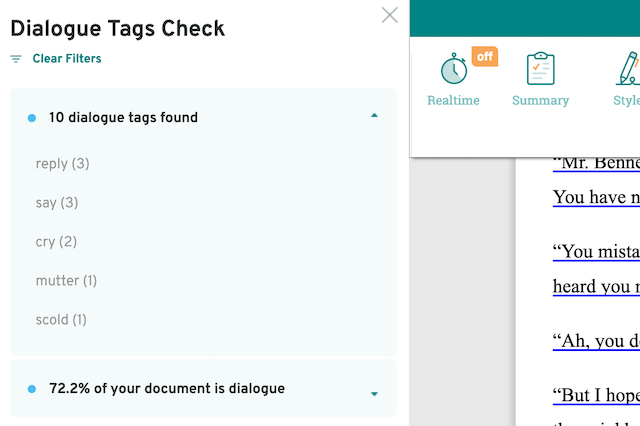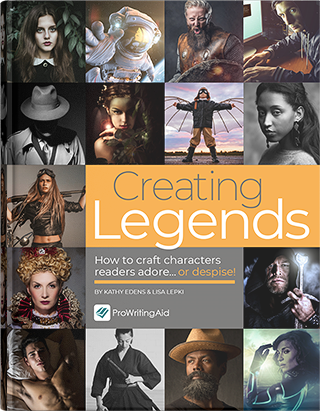
Dialogue is an integral part of most narrative fiction. When characters speak to one another, they reveal personality, plot, and conflict. However, it can be challenging to give our characters the right things to say. Let’s work on it in this article.
1. Omit Needless Words
Strunk and White had it right—especially when it comes to dialogue. "Omit needless words" is one of their key pieces of advice.
In everyday speech, people use many filler words. "Umm," "like," "yeah," and "well" are just a few. Yes, technically speaking, it’s realistic to use those words in dialogue. However, when used to the degree we use them in regular speech, they ruin dialogue. Sometimes writers leave these words in their work (or worse, add more), thinking it makes characters sound more natural. But the truth is, too many become glue to readers’ eyes. Omit those fillers whenever possible.
If you cut these words from your dialogue, it will draw readers attention to the important words. Fortunately, ProWritingAid can help omit those needless words with its Sticky Sentences check.
2. Add Action
A scene of dialogue need not just be conversing. It’s amazing what a little action can do.
For example, on the TV show Game of Thrones, one of Tywin Lannister’s first scenes is a conversation between himself and his son, Jaime. The dialogue in the scene is already excellent, but it’s further enhanced by Lord Tywin’s actions during the scene. He’s skinning a stag.
Not only does this show that Tywin is one scary dude; it underscores and reinforces the meaning of the dialogue between himself and his son. In this scene, they discuss mortality, clean deaths, and fear—all of which relate to skinning an animal (not to mention the stag is the sigil of House Baratheon, one of the Lannister’s greatest rivals). This action takes a good scene of dialogue and makes it outstanding.
Here are some actions your characters might take during a scene of dialogue:
Eating. What a character eats and the way they eat it gives great insight into that character, especially if they’re talking while doing it. (Chew before you speak, though, please. Unless that’s part of the character.)
Walking. This is a favorite technique of legendary screenwriter Aaron Sorkin because it works so well. When characters walk and talk simultaneously, it gives scenes a sense of urgency, not to mention a more dynamic setting.
Crafting. Have your character do something with their hands. Maybe they’re sculpting, painting, knitting, or writing. (Or skinning an animal, like Lord Lannister.)
Fighting. Whether it’s the final words before a duel or breathless insults hurled between blows, adding a fight to a scene of dialogue really brings things to life. And when both characters’ lives hang in the balance, readers will hang on every word.
Playing a game. Imagine a scene where two characters are playing chess. While they talk, the movement of the pieces suggests who has the upper hand in the conversation. For example, when one character makes a good point, you might have their knight capture their opponent’s bishop. But then the other character makes a good point, capturing the opponent’s knight with their queen.
Adding one of those actions to a stiff scene should help limber it up.
3. Use Subtext
People rarely say exactly what they mean. More often, we rely on subtext.
Subtext refers to moments when characters hint at meaning rather than state it. It’s the difference between saying, “I’m hungry” versus “Hey, there’s a Taco Bell... and look how short the line is!” Adding subtext to dialogue gives readers more to chew on, so to speak.
Let’s imagine, for example, that we have a character who wants a puppy. Here’s a scene where she attempts to convince her mom to buy one, sans subtext:
"Mom, I really really want a puppy," said Jessie. "They’re so cute and I would play with it all the time and I would clean up after it, even if it had an accident in the house."
"I don’t want to buy you a puppy," said Jessie’s mom. "It’s too much work."
This exchange is pretty boring because both characters state exactly how they feel. Let’s add a pinch of subtext to this dish.
"Mom, do you remember Buster? The neighbors’ puppy? Remember how cute he was? And remember what a good job they did taking care of him? He had accidents every now and then, but they trained him really well and he turned out to be a really nice dog. Remember how happy they looked?"
"Those kids never helped with Buster," Jessie’s mom pointed out. "Their poor mother raised him all by herself."
This dialogue is far more interesting because we’re showing the characters’ feelings rather than stating them. Jessie is clearly trying to manipulate her mom into buying a puppy. She’s reminding her mom how cute the neighbors’ dog was, and even implying that she would help raise it. Her mom, however, suggests that she would be the one to raise the puppy, not Jessie.
If you’ve got dialogue that isn’t working, try expressing the same ideas through subtext. It should liven your work up immensely.
Bonus Step: Use ProWritingAid’s Dialogue Check
ProWritingAid’s Dialogue Check tells you how much dialogue you’ve used, and when you’ve used unusual dialogue tags.
If your characters "shriek," "warble," or "sing" their lines, your reader is probably going to spend more time distracted by how unnatural your dialogue tags are than thinking about what your characters are saying. ProWritingAid will highlight your unusual dialogue tags for you so that you can work out if they’re the best fit for your scene:

When you see them in a list like this, it’s easier to spot where you might need to substitute a distracting dialogue tag with an action beat, or change up the dialogue itself with some subtext that shows emotion rather than telling it.
In Conclusion
Dialogue is more than just talking. It’s an important element of narrative fiction, and one that deserves attention. I hope these tips have helped improve yours!


